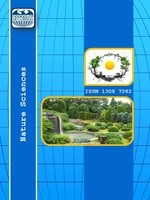TÜRKİYE’DE GELENEKSEL KIR KONUT YAPISININ 20. YÜZYILDAKİ DEĞİŞİMİNE YEŞİLOVA (BURDUR) ÖRNEĞİ
Türkiye’de 20. yüzyılda yaşanan ekonomik ve sosyo-kültürel değişimin etkisiyle kır konut yapısında gözle görülür derecede bir dönüşümün olduğu saptanmaktadır. Bunun derecesi yörelere göre farklılık gösterse de, birçok yerde belirgindir. Bu anlamda dikkat çeken yerlerden biri de Yeşilova (Burdur) çevresidir. Araştırmanın amacı, Yeşilova çevresindeki kır konutlarında tespit edilen değişim-dönüşüm sürecini sebep ve sonuçlarıyla ortaya koyabilmektir. Yöredeki kır konutlarının dönüşüm süreci birbirlerinden kesin hatlarla ayrılabilen üç safhada gerçekleşmiştir. Bileşik aile yapısının çözülmesi, ulaşım-iletişim sistemlerinin gelişmesi, yurt dışına ve şehirlere yönelik göçler bu süreçte etkili belli başlı faktörlerdir. Özellikle sürece yön veren popüler kültürün etkisiyle yöredeki kır konutları geleneksel yapıdan uzaklaşmış, hem fonksiyonel ve hem de şekilsel anlamda değişime uğramıştır.
Anahtar Kelimeler:
Geleneksel Kır Konutları, Kır Yerleşmeleri, Konut Yapı Değişimi, Kültür, Yeşilova (Burdur)
YE?ILOVA (BURDUR)- AN EXAMPLE OF CHANGE IN THE TRADITIONAL RURAL HOUSE STRUCTURE IN TURKEY DURING THE 20TH CENTURY
Due to the economic and socio-cultural change in the 20th century, it is noteworthy that there has been a remarkable transformation in the structure of the rural houses in Turkey. Although the degree of this transformation varies depending on the districts, it is evident in a large number of places. In this respect, one of the places that stands out is Ye?ilova (Burdur) and its surroundings. The purpose of this study is to reveal, with its causes and effects, the change-transformation process of the rural houses in the surroundings of Ye?ilova. The transformation of the rural houses in the district took place in three phases which differ markedly from each other. Dissolution of the joint family structure, advancements in transport-communication systems and emigration to urban areas and abroad are the main factors that have effect on this process. Particularly, due to the effect of the popular culture that leads this process, the rural houses in the district have moved away from the traditional pattern and they have been going through a change both in function and shape. In terms of transferring cultural heritage and traditional house structure of the district to the next generations, a regulation that is open to innovations and that preserves the traditional identity is needed. Key Words: Traditional rural house, rural settlements, change in house structure, culture, Ye?ilova (Burdur)
Keywords:
Traditional rural house rural settlements, change in house structure, culture, Ye?ilova (Burdur), ,
- Başlangıç: 2009
- Yayıncı: E-Journal of New World Sciences Academy
Sayıdaki Diğer Makaleler
DİYARBAKIR’DAKİ ALIŞVERİŞ MERKEZLERİNİN YER SEÇİMİNİ ETKİLEYEN FAKTÖRLER
ISPARTA’DA ARIMA MODELİNE GÖRE SENTETİK İKLİM VERİLERİNİN ANALİZİ
Muhammet BAHADIR, Sinan SARAÇLI
HEMŞEHRİLİK VE İZMİR’DEKİ HEMŞEHRİ DERNEKLERİ
Nevzat GUMUS, Nalan Kadiroğlu Altay
TOPRAKKALE (MUŞ) BARİT CEVHERLEŞMESİNİN JEOLOJİK VE PETROGRAFİK ÖZELLİKLERİ
TÜRKİYE’DE GELENEKSEL KIR KONUT YAPISININ 20. YÜZYILDAKİ DEĞİŞİMİNE YEŞİLOVA (BURDUR) ÖRNEĞİ
ŞEHİR NÜFUSUNUN DAĞILIMINDA SOSYAL VE EKONOMİK FAKTÖRLERİN ETKİSİ, ELAZIĞ ÖRNEĞİ
TÜRKİYE’DE (1998-2007) GÖRÜLEN ORMAN YANGINLARININ YÜZEY VE RAKAMSAL SORGULAMA ANALİZİ
